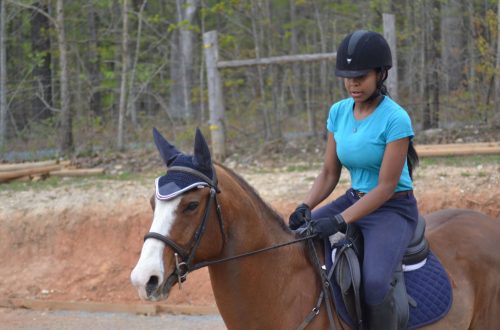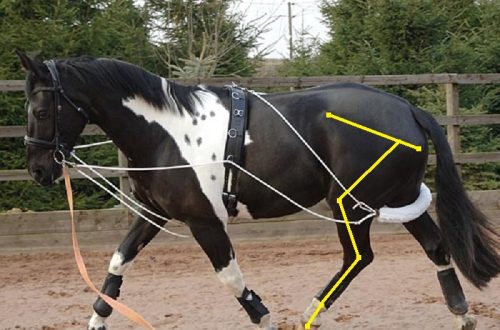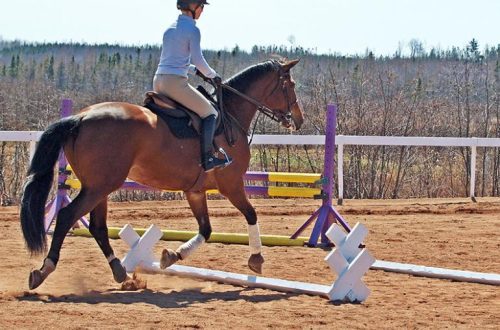
Warm-up for riders, beginners and beyond
Warm-up for riders, beginners and beyond
The rider, like the horse, must be prepared for training. The preliminary warm-up is especially important for beginner riders, as well as for those who, for one reason or another, experience physical discomfort while riding.
Warm up:
- warms up the lower and upper body by increasing the pace, heart rate, breathing rate and stretching the muscles;
- gives the rider time to get used to the horse and find their balance and coordination;
- develops awareness of one’s own body;
- improves the rider’s posture and centers him in the saddle;
- encourages improved flexibility and relaxes;
- increases the range of motion of the joints;
- builds trust;
- starts the lesson with a cheerful and energetic note;
- introduces movements that will later be used during training.
What should the instructor pay attention to?
Exercises should be performed in both directions, 5-10 repetitions. To make the warm-up more fun and relaxed, you can add elements of the game to it.·
Exercises should be chosen focusing on the student’s fitness, what he needs to work on, and the skills that he will learn next. Tasks should be given to the student exceed the limits of his current abilities, but do not harm him or his physical form.
The complexity of the exercises should increase gradually (for example, from easy stretching to more difficult).
The rider must be given time to understand what is being asked of him. If necessary, the instructor must demonstrate to him how to perform the exercise correctly or to put the student’s body in the correct position.
БоMost of the exercises should be done on the go. This way the student will get the maximum benefit from the movement of the horse. If the rider is afraid or too stiff, do the exercises with the horse standing still at first. So he can gain more confidence.
Train the rider slowly, slowly, observing how the work he does affects his position.
Remind the student to remember to breathe, and breathe deeply!
Exercises on the ground (performed before landing in the saddle)
Ball exercises
Most of the exercises listed below can be done before getting into the saddle using a gym ball.
The ball will help the rider improve the stability of the seat and allow one body part/movement to be worked independently of the others (this is very useful for creating “independent” arms).
If a rider has trouble being able to work one part of the body independently on the horse, it is helpful to practice the “mount” movement on the gym ball. The ball “behaves” like a horse when you make movements that upset the balance. Many skills can be first practiced on the ball and then transferred to the saddle.
1. Bounce on the ball
Sit straight, back and pelvis aligned. Hands in the “hold the rein” position. The rider bounces on the ball several times, then stops. During the stop, he must sit “high” and maintain the correct position of the sitting bones.
2. Independent hands
The rider sits on the ball and holds in his hands, as a rein, the ends of an elastic rope. The instructor, standing opposite, holds the rope in the middle. The rider, while bouncing on the ball, should try to keep his hands stable and maintain constant contact through the “rein”. Performing this exercise, the rider tries to sit “high” and even, connecting to work core muscles.
3. We are looking for an occasion
The rider sits on the ball, holding the ends of an elastic rope in his hands as a rein. The instructor, standing opposite, holds the rope in the middle. While the student is jumping on the ball, the instructor pulls the “reins” towards himself, trying to pull the rider out of the “saddle”. To maintain his position, the rider will need to engage the core muscles and keep the shoulders down and out.
4. Move your hips from side to side
Sitting on the ball, the rider rotates their hips from side to side. This exercise helps to relax the lower back and hips.
5. We bend the lower back, align the lower back
Sitting on the ball, the rider arches the lower back and then flattens it, which allows the hips and pelvis to take the correct position. Riding with an arched lower back or back can cause pain. The rider must be able to engage the abdominal muscles of the core so that the pelvis can assume a neutral position while riding. By practicing this on an exercise ball, the rider can improve pelvic awareness and improve fitness.
Saddle exercises
1. Exercises for the upper body of the rider:
- look down, up, to the sides;
- we look where we are going: the instructor leads the horse along winding paths, and the rider tries to turn his head and neck in the direction in which moves a horse without shifting or twisting in the body;
- relax the jaw – do not clench your teeth;
- shrug our shoulders;
- rotation of the shoulders – forward, backward;
- sit high (imagine that you are like a puppet, hung from the top of the head on a rope hanging from the ceiling, relax your back and let it move with the horse);
- we raise our hands up (elbows are straight, the gaze is directed forward!) – we stretch as high as possible without raising our shoulders – one arm at a time or both at the same time;
- arms forward (elbows straight, gaze directed forward!);
- arms back (elbows straight, gaze directed forward!);
- plane – arms to the sides (elbows straight, look ahead!);
- helicopter – arms to the sides, the body rotates left and right, etc .;
- body rotates, arms crossed in front;
- circular rotations of the hands – large and small circles, spirals from small circles to large ones and vice versa, one hand in turn or both at the same time;
- circular movements of the hands, performed in opposite directions;
- swimming – “swimming” with straight arms (hands alternately go back and forth);
- hands on hips while walking;
- hands on hips during stop-step-stop transitions;
- follow the shoulders of the horse (when the horse bends in a turn, its inner shoulder goes back, the horse does not fall inward);
- tilts – we lean forward (reach for the horse’s ears!) and backward (reach for the horse’s tail!), without moving the lower body, heels down;
- hug the horse and go back;
- touch the right toe with the right hand, the left toe with the left;
- touch the right toe with the left hand, the left toe with the right;
- touch both socks with both hands;
- we stretch our legs forward – hold them there for 5 deep breaths, strain our legs and abs, do not close our knees on the saddle;
- attach the clothespins to the horse’s mane and to the ammunition, the student should reach out to remove them. You can use colorful clothespins to add fun to the game (for example, “everyone takes off the yellow clothespin!”);
- stretch the rubber ring in the saddle;
- riding without stirrups – while walking, let the horse move your legs, put your hands on your hips and feel them relax, put your hands on your back and feel it move with the horse, count the beats of the hooves. The instructor can suggest which of the hooves is stepping on the ground, until the rider himself learns to determine this;
- soft look – look straight ahead and relax your gaze, try to connect your peripheral vision, and not focus on what is directly ahead of you. The instructor may stand in front of the Athlete or circle around the Athlete, asking the Athlete to speak when the Trainer disappears from his line of sight and when he appears. It helps to develop a sense of the arena, to learn to see what is happening in the entire arena, even if you are not looking in a certain direction;
- breathe belly – as if you were an accordion or a balloon. We breathe not from the chest. Note that your horse will probably relax too and begin to breathe more regularly. You can use this exercise when your horse is afraid of something;
- find your center – put your finger just below your navel and center yourself in the saddle, sit deep and stable;
- play the game “Simon says” (follow quickly alternating instructions from the instructor);
- passenger – the rider puts his hands on the shoulders of the horse, and the lead horse does crazy serpentines and arcs for 1-2 minutes, until the rider really relaxes in the movement;
- building blocks – build your “straight line” one block at a time: heels, hips, shoulders, head.
2. Exercises for the lower body
- circles / rocking of the legs;
- toes up, down;
- toes in, out;
- toe circles – twist your toes in all directions without touching the sides of the horse;
- we put rings on the toes of the rider’s boots – he will need to ride with his socks up;
- heels up, to the seat, alternately or both at the same time;
- raise the knees in the rhythm of the horse’s step alternately or both at the same time, preferably trying not to hold on to anything with your hands;
- dangling legs – performed without stirrups, knee relaxed, do not let the legs touch the horse, do not swing them with force, just let the movement of the horse swing them, let the leg be like a weight fixed on the knee;
- we pedal – we imitate cycling, we remain relaxed;
- hips to the side – move the hip (alternately) or both hips away from the saddle;
- scissors – one foot forward and one foot back, as far as possible, pull the toe, then change legs;
- up, down, back – one leg per approach. Raise the knee up and hold it at the top, counting to five, lower the knee down, counting five, take the knee back and counting to five;
- two-point landing;
- lighten up on the step;
- “5-5-5” – 5 steps in a two-point landing, 5 steps, easing, and 5 steps sitting;
- riding at two paces – we sit at one pace, we stand at two paces. This exercise helps to stabilize the leg and find balance!
3. Exercises for the whole body
- simple walking step. If the rider is very tense, he may walk a few laps in each direction to distract himself and relax his muscles;
- rotation in the saddle: the rider throws the stirrups, throws one leg over the horse’s neck and sits sideways, throws the leg over the croup and sits back to front, throws the leg over the croup and sits sideways to the other side, throws the leg over the horse’s neck and sits straight. Repeat in the other direction;
- Tree: Imagine that you are a tree stretching high up with its branches – turn your shoulders and sit “high” with your body. Your “roots” are strong and go deep down – you “lengthen” your legs and drop your heels down. Don’t do it by force, just let them come down under gravity;
- games with balance: we put rings on the toes of our shoes or put sandbags there. Or we place bags on the shoulders.
Recovery of acquired skills:
What the rider has already learned in the last week or earlier can be included in the warm-up before the current lesson.
Below I want to highlight therapeutic warm-up exercisessuitable for riders with certain physical characteristics, as well as stretching exercises.
Each exercise contains a description of HOW to perform it and WHY. It is very important to understand these HOW and WHY. You will be able to understand in what cases and for which students it is better to use them.
1. Ankle circles (one at a time) – several times in each direction, one leg per approach. This improves ankle flexibility, making it easier for the rider to drop the heel down and keep the feet in the stirrups properly.
2. Circular movements of the ankles (two) – both legs at the same time. Improves coordination of movements between the left and right limbs. Complicated version –circular movements of the ankles in opposite directions – both legs work in opposite directions.
3. Hands to the sides – one hand to the side. Allows the rider to feel safe during the exercise.
Arms out to the sides in a T-shape. Allows the rider to develop a sense of balance without letting him hold on with his hands. Promotes the expansion of the chest and “high” posture.
4. Hands to the sides and turns of the body to the left and right – affects the stretching of the lower back, involves the muscles of the press.
5. Hands up. Obottom arm up – allows you to stick to the saddle and feel safe while doing the exercise.
Both hands up – this is how the rider learns to develop a sense of balance without holding on with his hands. The exercise promotes “high” posture, helps riders to lower the shoulder blades down.
Both arms rise up, then gently bend at the elbows and wind back as you exhale. So the back muscles are additionally involved and stretched.
6. Castle behind the back – we stretch our fingers to each other behind the back (one hand on top, the other on the bottom), hands alternate. The rider’s chest unfolds, the shoulders unfold, the upper part of the body opens.
Lock behind the back with a forward tilt – a more intense stretch appears, the exercise also contributes to the deployment of the shoulders.
7. Touching the knee with the opposite hand – first we stretch the right hand to the left knee, then vice versa, using the waist. So the lower back and the press are included in the work, the skill is trained to work with the right side of the body separately from the left.
8. Touching the toe of the shoe with the opposite hand – we stretch the right hand to the left toe, then vice versa. This complicates the previous task, gives additional stretch for the lower back.
9. Dog – without stirrups, one leg per approach, raise the thigh away from the saddle with the legs extended forward (like arms to the sides, but with the legs). Develops centering in the saddle, the correct position, does not allow the rider to cling to the saddle with his thigh. Walking exercises help you become more aware of your body and develop a sense of balance.
10 Bring your elbows together – place your fingers on your shoulders or behind your head and bring your hands together so that the elbows touch in front of you, and the upper back is rounded. This stretches the upper back. If only one hand is out, the rider will be able to feel safe while doing the exercise and holding on to the saddle.
11 Frog – no stirrups, one leg per approach. Raise your knee towards the saddle pommel, then lower it down and back. This helps the rider find the middle of the saddle and stay in the right position using balance and seat. Doing the exercise with both feet at the same time during a stop or on a walk, the rider complicates his task.
12 Hands on the helmet – Both hands touch the top of the helmet. The rider sits “high” and level, maintains balance without sticking. An easier option is to work with one hand.
13 We touch the mane – we stretch along the mane forward with both hands. This stretches the muscles in your upper back.
14 Reach for the ears – the rider reaches forward along the mane with both hands as far as he can, without lying on the horse’s neck. This improves the quality of the stretch.
15 Quadriceps stretch – no stirrups, the rider holds their ankle up so that the knee is facing down and aligned with the pelvis. This exercise stretches the quadriceps muscle, tilting the pelvis forward to increase the stretch.
16 We reach for the tail – the rider turns around at the waist and reaches with one hand to the horse’s tail. This affects the flexibility of the spine and lower back of the rider. Deeper stretching will follow if, reaching for the tail, it lingers. in such a position.
17 Turns of the body – hands on the hips and arms to the sides, rotations at the waist to the left and right. The exercise warms up the muscles of the lower back, stretches them and increases flexibility, allows to achieve a better turn, helps some riders to more clearly define the turn in the loin.
18 We stand on the stirrups – we hold a strap or rein in our hands and stand exactly on the stirrups, maintaining balance, on the step. This helps the rider find center/balance and stabilize the correct leg position (for the rider to balance, the leg must be under the hip), encourages a deep stretch down into the heel. You can complicate the task by standing on stirrups without hands (hands in front of the body).
Cynthia Linsenbart; translation Valeria Smirnova based on site materials http://www.lessonsintr.com.





